|
 |
 Faery
Theories Faery
Theories
The following theories have
been advanced by folklorists to explain the coming of Faeries.
 Hades
Theory: Faeries are the souls of the unforgiven
dead, waiting to be reunited with there bodies at Judgment day Hades
Theory: Faeries are the souls of the unforgiven
dead, waiting to be reunited with there bodies at Judgment day |
 Mythological
Theory: Faeries are the diminished figures of
the old pagan celtic divinities Mythological
Theory: Faeries are the diminished figures of
the old pagan celtic divinities |
 Pigmy
theory: Faeries derive from a folk memory of a
prehistoric Mongolian race, which inhabited Britain and parts of Europe
but died out after its members where driven out by the celts Pigmy
theory: Faeries derive from a folk memory of a
prehistoric Mongolian race, which inhabited Britain and parts of Europe
but died out after its members where driven out by the celts |
 Druid
theory: Faeries derive from a folk memory of the
Druids and there magical practices Druid
theory: Faeries derive from a folk memory of the
Druids and there magical practices |
 Naturalistic
Theory:
Faeries are a continuation of a prehistoric beliefs in nature spirits Naturalistic
Theory:
Faeries are a continuation of a prehistoric beliefs in nature spirits |
 Psychological
theory: Faeries are the manifestation of a worldwide
doctrine of souls, and part of the universal animistic spirit Psychological
theory: Faeries are the manifestation of a worldwide
doctrine of souls, and part of the universal animistic spirit |
 Actual
theory: Faeries are a real race of supernatural
beings Actual
theory: Faeries are a real race of supernatural
beings |
From The Faeryland Companion
by Beatrice Phillpotts
|
 |
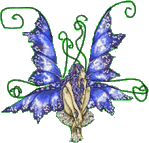  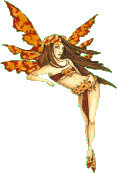
There are more types of fairies
then just the beautiful winged beings that I am most fond of. here's a
list of some of the different kinds.
 |
 Types
of Fairies Types
of Fairies
by JC Pinkerton
| There are so many different
types of fairies that one could never be sure which type they had seen
or heard. Although some people claim they know exactly which type they
have seen. Since ancient times they have been described as being seen and
heard in many different forms. All of the fairies below are said to be
afraid of a clergyman and will not enter a house while one is inside. |
 The
Banshee-Fairy Woman The
Banshee-Fairy Woman She can forewarn certain ancient
Irish families of impending death. She can appear in four different forms:
She can forewarn certain ancient
Irish families of impending death. She can appear in four different forms:
A young attractive woman.
A noble matron.
An old hag.
A washerwoman.
Her cry can be heard at night
near the home of someone who is about to die. Her wails have been described
as piercing to low and pleasant. She may also appear in other forms such
as a crow, weasel and other animals associated with sorcery. |
 The
Changelings The
Changelings It's been told that many fairy
children are born defective so their parents will swap them with a human
baby. A fairy child that has been swapped by their parents is called a
changeling. This little fairy has the power to cause evil in the human
household and is not a happy camper. It often screeches and yells throughout
the day and night. The home will have only bad luck with this fairy child
around. Often the child will grow up with a crooked back or hand but will
be gifted with talent to play a musical instrument such as the fiddle or
Irish pipes.
It's been told that many fairy
children are born defective so their parents will swap them with a human
baby. A fairy child that has been swapped by their parents is called a
changeling. This little fairy has the power to cause evil in the human
household and is not a happy camper. It often screeches and yells throughout
the day and night. The home will have only bad luck with this fairy child
around. Often the child will grow up with a crooked back or hand but will
be gifted with talent to play a musical instrument such as the fiddle or
Irish pipes. |
 The
Dullaghan The
Dullaghan This fairy rides a black steed
while he carries his head in his arms. Remember the story of the "Headless
Horseman?" Perhaps he was a dullaghan! He likes to show up around midnight
during Irish festivals and is said to be seen often in County Down, Ireland.
It is said the creature's head glows with luminescence of decaying matter
and serves the rider as a lantern to guide the dullaghan's way. A ghastly
grin runs from one side of the face to the other. Sometimes he is seen
driving a black coach drawn by six black horses.
This fairy rides a black steed
while he carries his head in his arms. Remember the story of the "Headless
Horseman?" Perhaps he was a dullaghan! He likes to show up around midnight
during Irish festivals and is said to be seen often in County Down, Ireland.
It is said the creature's head glows with luminescence of decaying matter
and serves the rider as a lantern to guide the dullaghan's way. A ghastly
grin runs from one side of the face to the other. Sometimes he is seen
driving a black coach drawn by six black horses. |
 The
Grogochs The
Grogochs These are dirty little half-human,
half-fairy creatures. They appear as an elderly man who wears no clothes
but is covered with dirt, twigs, etc. It's been said they like to occupy
the Isle of Man. This creature can make himself invisible but will reveal
himself to someone he likes. He enjoys roaming about the kitchen and causing
disturbances.
These are dirty little half-human,
half-fairy creatures. They appear as an elderly man who wears no clothes
but is covered with dirt, twigs, etc. It's been said they like to occupy
the Isle of Man. This creature can make himself invisible but will reveal
himself to someone he likes. He enjoys roaming about the kitchen and causing
disturbances. |
 The
Leprechaun The
Leprechaun These elderly gentlemen are often
found in a state of intoxication from drinking their "home-brew." But be
that as it may, they are talented shoemakers and can hammer away drunk
or sober. The leprechaun carries a "magical coin" in his purse and each
time he pays it out it always returns back to him, showing up in his purse
again and again. He has been described as Ireland's national fairy and
only a leprechaun knows where the pot of gold is. But he's not telling!
These elderly gentlemen are often
found in a state of intoxication from drinking their "home-brew." But be
that as it may, they are talented shoemakers and can hammer away drunk
or sober. The leprechaun carries a "magical coin" in his purse and each
time he pays it out it always returns back to him, showing up in his purse
again and again. He has been described as Ireland's national fairy and
only a leprechaun knows where the pot of gold is. But he's not telling! |
 The
Merrows The
Merrows The Irish female merrow is a beautiful
marine fairy who has thin webbing between her fingers and prefers human
male mates. Some people say they bring messages of death. They can travel
through the sea wrapped in a cloak and can even take on the appearance
of a seal. Sometimes they find old shipwrecks and carry away lots of treasure
making them wealthy creatures. Some have married human fishermen and had
children, only to return back to the sea. The male merrows sometimes appear
as little hornless cows. Sometimes they appear as a fairy with green teeth
and green hair. Is it any wonder the female merrow doesn't find them attractive?
The Irish female merrow is a beautiful
marine fairy who has thin webbing between her fingers and prefers human
male mates. Some people say they bring messages of death. They can travel
through the sea wrapped in a cloak and can even take on the appearance
of a seal. Sometimes they find old shipwrecks and carry away lots of treasure
making them wealthy creatures. Some have married human fishermen and had
children, only to return back to the sea. The male merrows sometimes appear
as little hornless cows. Sometimes they appear as a fairy with green teeth
and green hair. Is it any wonder the female merrow doesn't find them attractive? |
 The
Pooka The
Pooka This is the most fearful fairy
in all of Ireland. It comes out at dark, causing injury and mischief. It
can take on many different forms but usually appears as a dark horse with
infernal yellow eyes and a trailing mane. It scatters livestock, knocks
down fences and tramples crops. Sometimes it demands a portion of the crop
and farmers have to leave an offering behind. You'll know when one is around
because the cows won't milk, the chickens won't lay and all of your animals
will think they're in a Stephen King novel.
This is the most fearful fairy
in all of Ireland. It comes out at dark, causing injury and mischief. It
can take on many different forms but usually appears as a dark horse with
infernal yellow eyes and a trailing mane. It scatters livestock, knocks
down fences and tramples crops. Sometimes it demands a portion of the crop
and farmers have to leave an offering behind. You'll know when one is around
because the cows won't milk, the chickens won't lay and all of your animals
will think they're in a Stephen King novel. |
 The
Sheoques The
Sheoques These little fairies live in thorn
bushes and can lead you astray with their fairy music. If you see any of
these little critters, better cover your ears and hope for the best.
These little fairies live in thorn
bushes and can lead you astray with their fairy music. If you see any of
these little critters, better cover your ears and hope for the best. |
 Who
Could Forget About These Sweet Fairies? Who
Could Forget About These Sweet Fairies?
|
 Fairy
Godmother Fairy
Godmother
A popular fairy in animated
films and picture books, the fairy godmother shows up unannounced when
the heroine is in a state of desperation and has nowhere else to turn.
The fairy godmother usually keeps watch over a female character and is
always a plump and sweet grandmotherly type. If you write about her be
sure to give her a long flowing gown with lots of lace, a hooded cape,
and tall sorcerer's hat. And don't forget the magic wand. She'd be lost
without it. |
 The
Tooth Fairy The
Tooth Fairy This little creature is quiet
and stealthy, she'll always appear in the middle of the night but you won't
know it because she won't make a sound. If you've put your tooth under
your pillow like you should, she'll collect it and leave you some money.
The good fairy always pays for the teeth she collects.
This little creature is quiet
and stealthy, she'll always appear in the middle of the night but you won't
know it because she won't make a sound. If you've put your tooth under
your pillow like you should, she'll collect it and leave you some money.
The good fairy always pays for the teeth she collects. |
 Fairy
Princess Fairy
Princess The fairy princess is about the
size of a butterfly and comes from a line of royalty. Kindness is her best
friend and she goes about looking for other fairies who might be in distress,
perhaps trapped by a mean dog or locked up by some mean human. The fairy
princess trust only little human girls for they are known to keep the fairies
secrets.
The fairy princess is about the
size of a butterfly and comes from a line of royalty. Kindness is her best
friend and she goes about looking for other fairies who might be in distress,
perhaps trapped by a mean dog or locked up by some mean human. The fairy
princess trust only little human girls for they are known to keep the fairies
secrets. |
|
 |
  
Other bits of lore
about Fairies
 |
(these bits here gathered
from various sights online and in some cases given to me by Shadowdragyn
of the ladies of the myst)
Faery Rings

 Faeries
often dance in circles in the grass which are called Faery rings. The wild
enchantment of the Faery music can lead passersby inexorably towards the
ring which, like a Faery kiss or Faery food and drink, can lead to captivity
forever in the world of Faery. If a human steps into the ring he is compelled
to join the faeries in their wild prancing. The dance might seem to last
only minutes, or an hour or two, or even a whole night but in fact the
normal duration would be seven years by our time and sometimes longer.
The captive can be rescued by a friend who, with others holding his coat-tails,
follows the Faery music, reaches into the ring (keeping one foot firmly
outside) and pulls the dancer out. Faeries
often dance in circles in the grass which are called Faery rings. The wild
enchantment of the Faery music can lead passersby inexorably towards the
ring which, like a Faery kiss or Faery food and drink, can lead to captivity
forever in the world of Faery. If a human steps into the ring he is compelled
to join the faeries in their wild prancing. The dance might seem to last
only minutes, or an hour or two, or even a whole night but in fact the
normal duration would be seven years by our time and sometimes longer.
The captive can be rescued by a friend who, with others holding his coat-tails,
follows the Faery music, reaches into the ring (keeping one foot firmly
outside) and pulls the dancer out.
|
Fairyland

 Where
is Faeryland? One day its just over the horizon and the next day its under
your feet. There has been times in history that Faeryland, had an actual
geographical area. However, the actual location tended to shift so
unwanted mortals do not happen to visit when they where not wanted. There
are two Faeryland most used throughout history they are The Isle of Man
and Avalon. Where
is Faeryland? One day its just over the horizon and the next day its under
your feet. There has been times in history that Faeryland, had an actual
geographical area. However, the actual location tended to shift so
unwanted mortals do not happen to visit when they where not wanted. There
are two Faeryland most used throughout history they are The Isle of Man
and Avalon.
 Most
traditional homes for faeries are forts, barrows and ancient earthworks,
these earthworks are know as faery hills. Keep in mind that it is
not recommended that any faery hill, or other habitat be trespassed on.
However, observing faery activity from a distance is allowed. Most
traditional homes for faeries are forts, barrows and ancient earthworks,
these earthworks are know as faery hills. Keep in mind that it is
not recommended that any faery hill, or other habitat be trespassed on.
However, observing faery activity from a distance is allowed.
 Fairies
may live alone or in large groups. Large groups of fairies live in
fairyland. They have a fairy society that has its own government and territory.
A king and queen rule Faeryland, with the queen having the most power.
Life in the Faeryland closely resembles life in the human world.
Fairies work, marry and have children. Time passes extremely slow in fairyland
and there is no old age or death (it is unknown if the part on death
is true since there have been faery funeral sightings) Fairies
may live alone or in large groups. Large groups of fairies live in
fairyland. They have a fairy society that has its own government and territory.
A king and queen rule Faeryland, with the queen having the most power.
Life in the Faeryland closely resembles life in the human world.
Fairies work, marry and have children. Time passes extremely slow in fairyland
and there is no old age or death (it is unknown if the part on death
is true since there have been faery funeral sightings)
 Finvara
is the King of the Daoine Sidhe and his Queen is Oonagh. People also think
of Oberon and Titana, but those are simply characters in a play.
Mab is also often referred to as the Queen of Faerie, but I can find no
reference to where that title comes from. The Daoine Sidhe (theena shee)
are supposedly the remnants of the Tuatha De Danann (tootha de dannan)
people of Ireland. That is the most accepted explanation. It
is NOT the real case, but would Finvara
is the King of the Daoine Sidhe and his Queen is Oonagh. People also think
of Oberon and Titana, but those are simply characters in a play.
Mab is also often referred to as the Queen of Faerie, but I can find no
reference to where that title comes from. The Daoine Sidhe (theena shee)
are supposedly the remnants of the Tuatha De Danann (tootha de dannan)
people of Ireland. That is the most accepted explanation. It
is NOT the real case, but would
work as fact for most
people.
|
Fairies and people

 Humans
have been (since the beginning of Christianity in Ireland) afraid of the
Faeries. They leave offerings of milk, broken bread, cheese, nuts,
sweets, etc. in hopes of gaining the Fae's good graces. They also
had a variety of methods to protect themselves against Faeries, most of
which are the same as for Vampires - anything having to do with Christianity
is supposed to keep them away. Also salt, iron, bells, daisy
chains, flax, St. John's Wort, horseshoes, shoes placed by the bed with
toes pointing away, a sock under the bed, turning clothing inside out,
sprigs of Rowan Humans
have been (since the beginning of Christianity in Ireland) afraid of the
Faeries. They leave offerings of milk, broken bread, cheese, nuts,
sweets, etc. in hopes of gaining the Fae's good graces. They also
had a variety of methods to protect themselves against Faeries, most of
which are the same as for Vampires - anything having to do with Christianity
is supposed to keep them away. Also salt, iron, bells, daisy
chains, flax, St. John's Wort, horseshoes, shoes placed by the bed with
toes pointing away, a sock under the bed, turning clothing inside out,
sprigs of Rowan
 They
did use eggshells in one test for Faerie Changelings. The human goes
through the motions of boiling water in empty halves of eggshells, which
is supposed to cause the changeling baby to stand and say that he has never
before seen such a thing in all his days. They also used a test of
putting the suspected changeling on a red-hot shovel, at which point the
changeling would fly up the chimney, and the real baby found outside
the door. They
did use eggshells in one test for Faerie Changelings. The human goes
through the motions of boiling water in empty halves of eggshells, which
is supposed to cause the changeling baby to stand and say that he has never
before seen such a thing in all his days. They also used a test of
putting the suspected changeling on a red-hot shovel, at which point the
changeling would fly up the chimney, and the real baby found outside
the door.
 Faeries
also are offended if humans give offers of thanks for help or tell any
other mortal about the help, they always return more than they borrow -
but NEVER should a human return more than borrowed to the Faeries.
It is also said that humans should never eat Faerie food, and that most
things the Faeries give is really just leaves and twigs disguised by "Glamour". Faeries
also are offended if humans give offers of thanks for help or tell any
other mortal about the help, they always return more than they borrow -
but NEVER should a human return more than borrowed to the Faeries.
It is also said that humans should never eat Faerie food, and that most
things the Faeries give is really just leaves and twigs disguised by "Glamour". |
|
 |
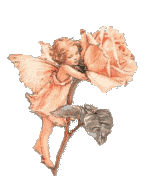  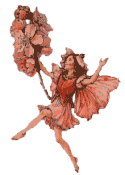
More Bits of Faery Lore
 |
 Faeries
are curious about humans and are ready to love them but they can be tricksters
as they are also afraid and distrustful of us and angry for the way we
treat the Earth they take care of. To placate them, we must align ourselves
with the ways of Nature and love everything that lives in our gardens both
beautiful and not so beautiful. We must try to see the essence of the spirit
in the flowers. Faeries
are curious about humans and are ready to love them but they can be tricksters
as they are also afraid and distrustful of us and angry for the way we
treat the Earth they take care of. To placate them, we must align ourselves
with the ways of Nature and love everything that lives in our gardens both
beautiful and not so beautiful. We must try to see the essence of the spirit
in the flowers.
 There
is always a main angel of the garden. The fae that tend to all living things
in your garden are under her direction. Speak to her and invoke her presence
each time you are in your garden. This blesses your garden and yourself. There
is always a main angel of the garden. The fae that tend to all living things
in your garden are under her direction. Speak to her and invoke her presence
each time you are in your garden. This blesses your garden and yourself.
 Nurture
feelings of wonder, reverence and love for every detail of your garden.
Once you truly feel the magic of opening your heart to the faeries, they
will make themselves known to you. Sometimes they will speak to you, giving
wise counsel and revealing secrets of the life of your garden. Nurture
feelings of wonder, reverence and love for every detail of your garden.
Once you truly feel the magic of opening your heart to the faeries, they
will make themselves known to you. Sometimes they will speak to you, giving
wise counsel and revealing secrets of the life of your garden. |

 Faeries
in the garden are often disguised as dragonflies or wrens. Faeries
in the garden are often disguised as dragonflies or wrens.
 All
cats have faery sight by nature. If you see your cat alert to something
in the garden you cannot see, it is most likely a faery. All
cats have faery sight by nature. If you see your cat alert to something
in the garden you cannot see, it is most likely a faery.
 As
a habit, faeries usually travel in small bands. They change residence four
times a year and this occurs on four pagan fire festivals: Imbolc, Beltane,
Lugnassad and Samhain. As
a habit, faeries usually travel in small bands. They change residence four
times a year and this occurs on four pagan fire festivals: Imbolc, Beltane,
Lugnassad and Samhain.
 Faeries
may be dwelling nearby if you spot mushrooms growing in a circle. This
is evidence of boundary markers of faery rings which are frenzied circle
dances of intoxicated faeries. Faeries
may be dwelling nearby if you spot mushrooms growing in a circle. This
is evidence of boundary markers of faery rings which are frenzied circle
dances of intoxicated faeries.
 The
best time to see faeries is at dusk on Midsummer eve(the Midsummer Solstice/on
or around June 21st). A wash of marigold applied to the eyelids will help
gain faery sight. Don't do more than look or you may be lured and sucked
into the seductiveness of the Otherworld! The
best time to see faeries is at dusk on Midsummer eve(the Midsummer Solstice/on
or around June 21st). A wash of marigold applied to the eyelids will help
gain faery sight. Don't do more than look or you may be lured and sucked
into the seductiveness of the Otherworld!
|

 Weeds
are considered wild herbs. Don't clear them away when they are in bloom
as the fae that live in them will be extremely upset! Weeds
are considered wild herbs. Don't clear them away when they are in bloom
as the fae that live in them will be extremely upset!  Marigolds
will discourage sprouting of weed growth and foxglove keeps weeds and disease
at bay. Marigolds
will discourage sprouting of weed growth and foxglove keeps weeds and disease
at bay.
|
Attracting Faeries

 Set
out birdhouses, birdbaths (float flower blossoms), bird feeders and bat
houses. Set
out birdhouses, birdbaths (float flower blossoms), bird feeders and bat
houses.
 Grow
plants and flowers that are attractive to bees and butterflies. The fae
are attracted to where they are. Grow
plants and flowers that are attractive to bees and butterflies. The fae
are attracted to where they are.
 Create
a small fountain, waterfall or fishpond (fishponds attract all sorts of
wildlife)to attract faeries and water sprites. Anything that reflects light
or is colorful and moving will attract the gnomes and elves. Create
a small fountain, waterfall or fishpond (fishponds attract all sorts of
wildlife)to attract faeries and water sprites. Anything that reflects light
or is colorful and moving will attract the gnomes and elves.
 Leave
an area of your garden a bit wild and uncultivated. Dedicating it to the
faeries will make them feel very welcome. Leave
an area of your garden a bit wild and uncultivated. Dedicating it to the
faeries will make them feel very welcome.
 Don't
remove mushrooms or fungus from your garden as the faeries regard these
as delicacies. Don't
remove mushrooms or fungus from your garden as the faeries regard these
as delicacies. |

 Faery’s
are very attracted to gardens where they feel they are welcome and gardening
is done in sympathy with nature and the plants that are their love and
charges. Faery’s
are very attracted to gardens where they feel they are welcome and gardening
is done in sympathy with nature and the plants that are their love and
charges.
 Always
leave at least a small wild area that is not cultivated (though it can
be cut carefully several times a year - like a wild meadow) or disturbed Always
leave at least a small wild area that is not cultivated (though it can
be cut carefully several times a year - like a wild meadow) or disturbed
 grow
plants and design the garden to attract wildlife grow
plants and design the garden to attract wildlife
choose natural wild flowers,
herbs and non-sterile hybrids. The faery’s are not sure of the energy of
the modern hybrid flowers,
 It
was an old tradition to build a small faery house out of natural materials
and to grow within it mushrooms and wild plants that they like. It
was an old tradition to build a small faery house out of natural materials
and to grow within it mushrooms and wild plants that they like.
 Sit
in the garden and listen for their singing. Hang up wind chimes and listen
to the wind through the trees and recognise the faery voices within it. Sit
in the garden and listen for their singing. Hang up wind chimes and listen
to the wind through the trees and recognise the faery voices within it.
 Clean
water is very attractive to all faery's, not just the water faery's. A
bowl of crystal clear water placed in a room sweetens the atmosphere and
forms a link to the spiritual planes. Clean
water is very attractive to all faery's, not just the water faery's. A
bowl of crystal clear water placed in a room sweetens the atmosphere and
forms a link to the spiritual planes.
|

 Faery’s
love beautiful, pure objects and may even be said to have rather flashy
(but not really gaudy) tastes in jewellery. They love gold and silver and
precious gems and can be very attracted to good-quality crystals (that
have not been extracted by unkind means). Faery’s
love beautiful, pure objects and may even be said to have rather flashy
(but not really gaudy) tastes in jewellery. They love gold and silver and
precious gems and can be very attracted to good-quality crystals (that
have not been extracted by unkind means).
 Faery’s
themselves will be seen dressed in green finery, such as foliage and pretty
flowers round their waists, heads or necks (and I am told to say: look
very pretty too!). Faery’s
themselves will be seen dressed in green finery, such as foliage and pretty
flowers round their waists, heads or necks (and I am told to say: look
very pretty too!).
 Brownie’s
have always traditionally liked small offerings of milk, honey, cakes or
ale to be left out for them and in turn will help around the house. Brownie’s
have always traditionally liked small offerings of milk, honey, cakes or
ale to be left out for them and in turn will help around the house.
 To
attract faery energy to the home have some pictures or figures of them
around, particularly if there is an area of the home set-up as a quiet
place, where you can meditate and ask for their help. A few acorns gathered
in a lane, a flower found lying on a verge (don't pick them from living
plants), a few autumn leaves will always be recognised and appreciated.
Each morning thank them for their help and ask that that help continues. To
attract faery energy to the home have some pictures or figures of them
around, particularly if there is an area of the home set-up as a quiet
place, where you can meditate and ask for their help. A few acorns gathered
in a lane, a flower found lying on a verge (don't pick them from living
plants), a few autumn leaves will always be recognised and appreciated.
Each morning thank them for their help and ask that that help continues.
|

 Faeries
are attracted to anything that glitters. Get a small basket and place
in it offerings to the faeries such as candles, ground ginger, clover (only
the three leaf), thyme, barley, foxglove, primrose, roses, and moss.
Tie the basket with bright colored ribbons for an added affect. Be
sure to replace the items often, as the faeries use that which is inside
and leave the outer shell of the objects. Faeries
are attracted to anything that glitters. Get a small basket and place
in it offerings to the faeries such as candles, ground ginger, clover (only
the three leaf), thyme, barley, foxglove, primrose, roses, and moss.
Tie the basket with bright colored ribbons for an added affect. Be
sure to replace the items often, as the faeries use that which is inside
and leave the outer shell of the objects.
 Oak
Hawthorne, and Ash Trees are among the best natural places to find faeries.
Outside of your faery garden look in these natural settings. Oak
Hawthorne, and Ash Trees are among the best natural places to find faeries.
Outside of your faery garden look in these natural settings.
 Provide
for faeries places in which to build their residence, shelter from the
weather, and happiness. Provide
for faeries places in which to build their residence, shelter from the
weather, and happiness.
|

 Cowslip-
This is the best for attracting faeries into your yard. Loved and guarded
by faeries. This flower has power to find hidden faerie gold. Cowslip-
This is the best for attracting faeries into your yard. Loved and guarded
by faeries. This flower has power to find hidden faerie gold.
 Willow:
Faerie Lore has it that at dusk. Willow trees will magically uproot, and
stalk and speak to wayward travelers. Willow:
Faerie Lore has it that at dusk. Willow trees will magically uproot, and
stalk and speak to wayward travelers.
 Roses:
The scent of Rose is a powerful attraction for the Faeire folk. Sprinkling
an area with rose water, or even your clothing, for that matter, will certainly
draw the Faeire near. Roses:
The scent of Rose is a powerful attraction for the Faeire folk. Sprinkling
an area with rose water, or even your clothing, for that matter, will certainly
draw the Faeire near.
 Metals
such as copper, and silver are sacred to the Faeire. Mesmerized by the
glitter, Faeire will gather to these metals. Metals
such as copper, and silver are sacred to the Faeire. Mesmerized by the
glitter, Faeire will gather to these metals.
 Wood
also holds an attraction power over the Faeire. Wood
also holds an attraction power over the Faeire.
 Faeiries
inhabit Mother Earth, especially trees. Faeire naturally flock towards
the woods. Faeiries
inhabit Mother Earth, especially trees. Faeire naturally flock towards
the woods.
 Plant
a wide assortment of colorful and sweet scented flowers in your garden.
Soon you will catch a glimpse of the Faeiries, just when you least expect
it, and usually between blinks of the eye. Any flowering plant that attracts
butterflies will certainly attract faeries. For faeries are forever pursing
butterflies. Plant
a wide assortment of colorful and sweet scented flowers in your garden.
Soon you will catch a glimpse of the Faeiries, just when you least expect
it, and usually between blinks of the eye. Any flowering plant that attracts
butterflies will certainly attract faeries. For faeries are forever pursing
butterflies.
|
A Spell to Call a Faery

 Chant
this while in the woods, a forest, or other secluded place: Chant
this while in the woods, a forest, or other secluded place:
Faery Folk, Faery Folk,
Faeries & the Fee
Give me the sight so that
I may see
I come with a light heart
feeling happy & gay
Show yourself to
me on this day
 In
England, a hob is a type of house faery who protects the kitchen. Leave
a little offering of sweet milk and bread on your stove for the hobs to
encourage their presence. In
England, a hob is a type of house faery who protects the kitchen. Leave
a little offering of sweet milk and bread on your stove for the hobs to
encourage their presence. |

 In
Ireland, the Tuatha de Danann are active just before Samhain and will bless
your home for a small portion of your harvest. Buy any crops left unharvested
after sundown on October 31st is taken by the Phookas, baneful faeries
who render the crop unfit to eat. Spelled Pwca in Wales, these baneful
faeries will remain active until spring! In
Ireland, the Tuatha de Danann are active just before Samhain and will bless
your home for a small portion of your harvest. Buy any crops left unharvested
after sundown on October 31st is taken by the Phookas, baneful faeries
who render the crop unfit to eat. Spelled Pwca in Wales, these baneful
faeries will remain active until spring!
 In
Cornwall it is a folk custom to scold a child who has spilled In
Cornwall it is a folk custom to scold a child who has spilled
milk, for this is seen as
a gift to the Faeries and scolding would make it seem as if it were given
grudgingly. This is probably the origin of the popular doggerel, "Don't
cry over spilled milk".
 There
are many well known ways to see Faery Folk. One is simply to gaze through
the opening of a holey stone or self-bored stone. These are usually found
near running water or by the sea. There
are many well known ways to see Faery Folk. One is simply to gaze through
the opening of a holey stone or self-bored stone. These are usually found
near running water or by the sea.
 They
are often seen within a natural ring of mushrooms at sunset or full moonlight. They
are often seen within a natural ring of mushrooms at sunset or full moonlight.
 When
seeking nature spirits never wear iron or whistle in the woods. When
seeking nature spirits never wear iron or whistle in the woods.
 Once
you have a faerie in your home, never leave it monetary gifts. A thimble
of milk and a little bread with honey will do just fine. Once
you have a faerie in your home, never leave it monetary gifts. A thimble
of milk and a little bread with honey will do just fine.
|

 Apple
trees - It is believed that fairies inhabit them and could enchant
mortals who lingered beneath them and carry them off to Fairyland. Apple
trees - It is believed that fairies inhabit them and could enchant
mortals who lingered beneath them and carry them off to Fairyland.
 Lily
of the Valley - The tiny flowers and sweet smell are perfect size for
the wee ones. Lily
of the Valley - The tiny flowers and sweet smell are perfect size for
the wee ones.
 Rosemary
- It is called the elf plant, and fairlore states they are Rosemary
- It is called the elf plant, and fairlore states they are
enchanted by the scent.
 Thyme
- This is their favorite! You may get a glimpse of your fairies playing
delightfully amongst it. Thyme
- This is their favorite! You may get a glimpse of your fairies playing
delightfully amongst it.
 Ferns
- Grow them near the thyme beds with plenty of soft moss around and the
fairies will make their beds in it! Ferns
- Grow them near the thyme beds with plenty of soft moss around and the
fairies will make their beds in it!
 Oak
tree - It is believed that holes near the bottom of old trees are the
doorway to Fairy Land! Oak
tree - It is believed that holes near the bottom of old trees are the
doorway to Fairy Land!
 Forget-Me-Nots
- Hold the blue flowers and wish....if you are pure and true...the keys
of fairy land will come to you. Forget-Me-Nots
- Hold the blue flowers and wish....if you are pure and true...the keys
of fairy land will come to you.
|

 In
traditional English folklore, the land of Faerie was a place out of space
and out of time. If a person visited this realm, a stay of a few
days might be the same as a hundred years in "real time." In
traditional English folklore, the land of Faerie was a place out of space
and out of time. If a person visited this realm, a stay of a few
days might be the same as a hundred years in "real time."
 Install
a small fountain or waterfall or put in a fishpond. You might want to include
statues of faeries. Anything that reflects light or is colourful and moving
particularly attracts the gnomes and elves. Both faeries and water sprites
like the splashy sound and sight of a fountain. Install
a small fountain or waterfall or put in a fishpond. You might want to include
statues of faeries. Anything that reflects light or is colourful and moving
particularly attracts the gnomes and elves. Both faeries and water sprites
like the splashy sound and sight of a fountain.
 Faeries
of the garden variety have a fondness for thyme, clover {three leaves only,
as the four leafed variety will repel the little creatures}, primrose,
and of course hawthorn which is sacred to the Faeries. Faeries
of the garden variety have a fondness for thyme, clover {three leaves only,
as the four leafed variety will repel the little creatures}, primrose,
and of course hawthorn which is sacred to the Faeries.
 Foxglove,
also called Faerie petticoats, Faerie thimbles, and foxglove will provide
the wee folk with many garment options and should be grown in every garden
desirous of Faeries. Foxglove,
also called Faerie petticoats, Faerie thimbles, and foxglove will provide
the wee folk with many garment options and should be grown in every garden
desirous of Faeries.
 Faeries
also dress in moss, fox skins, and spider webs. Faeries
also dress in moss, fox skins, and spider webs.
|

 If
a young maid will look for the first harebells of spring, which are called
"fairy thimbles" and are witch's flowers, and then count them up three
times as the sun is rising or the dew is falling, she can summon the fairies.
She, on leaving, must address them thus: If
a young maid will look for the first harebells of spring, which are called
"fairy thimbles" and are witch's flowers, and then count them up three
times as the sun is rising or the dew is falling, she can summon the fairies.
She, on leaving, must address them thus:
'Fairies I have sought your bower;
I now retire, and bless your power.'
She must curtsey three times
to the fairies, and the magic of the glade will go with her. |
|
 |
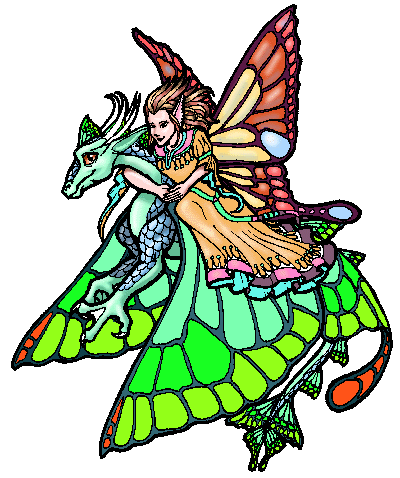

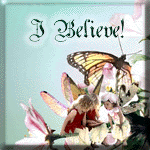

You are visitor number
To this page

The Music on this page is
"Only if" by Eyna


|